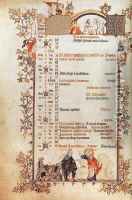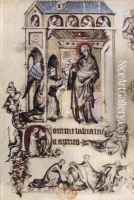Jean Pucelle Paintings
Jean Pucelle was a French Gothic-era manuscript illuminator who flourished in the first half of the 14th century, primarily in Paris. His exact dates of birth and death are not known, but it is generally believed that he was born around the turn of the 14th century and died around 1355. Pucelle is noted for his contribution to the advancement of the Parisian Gothic style of manuscript illumination.
Pucelle’s work is characterized by its elegance, attention to detail, and incorporation of architectural and spatial elements that reflect the emerging sensibilities of the time. He is best known for his work on the 'Hours of Jeanne d'Evreux', a devotional book made for the queen of France, Jeanne d'Evreux, between 1324 and 1328. The book is considered a masterpiece of Gothic manuscript illumination and demonstrates Pucelle's skill in creating intricate and expressive miniatures that combine religious themes with delicate courtly figures and scenes of everyday life.
Jean Pucelle's contributions to art go beyond his technical skill; he was influential in the transition from the Byzantine-influenced medieval style to a more naturalistic approach that would eventually lead to the Renaissance. His figures are more three-dimensional and show a greater sense of movement and emotion than those of his contemporaries. He often used grisaille, a technique involving a predominantly monochromatic palette, to create sculptural effects, which was innovative for his time.
Pucelle's influence was considerable in the development of the International Gothic style, and his techniques and aesthetic choices were emulated by subsequent generations of illuminators. Despite the lack of extensive records of his life and the exact details of his training and career, Jean Pucelle remains an important figure in the history of art. His legacy is primarily contained within the pages of the precious few manuscripts that have been attributed to him with confidence, each page a testament to his skill and artistic vision.

